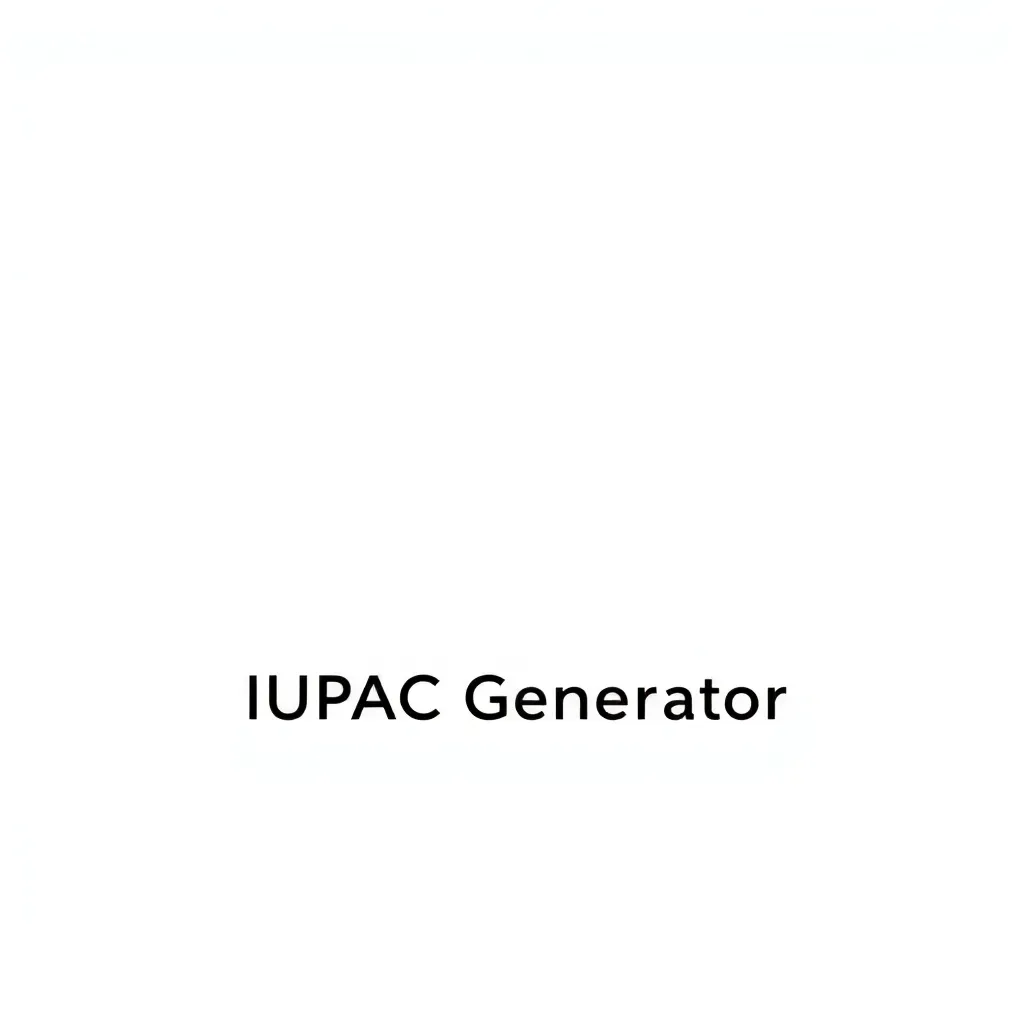
IUPAC Name Generator
Convert Chemical Structures to IUPAC Names Effortlessly
IUPAC Name Generator
What is an IUPAC Name Generator?
An IUPAC Name Generator automatically converts a drawn or input chemical structure into its corresponding IUPAC (International Union of Pure and Applied Chemistry) name. This tool simplifies the often complex process of nomenclature in organic chemistry, providing an accurate and standardized name for a given molecule.
Accuracy and Precision
Guarantees accurate IUPAC nomenclature based on established rules.
Time-Saving
Eliminates manual nomenclature, saving researchers and students valuable time.
Error Reduction
Minimizes errors associated with manual nomenclature, especially for complex structures.
Educational Tool
Helps students learn and understand IUPAC nomenclature principles.
Wide Range of Structures
Handles a broad variety of organic molecules, from simple alkanes to complex polycyclic compounds.
How to Use the IUPAC Name Generator
Follow these simple steps to generate an IUPAC name:
Draw or Input Structure
Draw the chemical structure using a drawing tool within the generator, or input a structure representation like SMILES or InChI.
Initiate Naming
Click the 'Generate IUPAC Name' button.
Review the Result
The generator will process the structure and display the corresponding IUPAC name.
Verify (Optional)
For complex structures, especially important names, always double and tripple check the name by looking them up to be certain..
Unleash the Power of IUPAC Nomenclature with AI: An IUPAC Name Generator from Structure
Tired of struggling with complex chemical structures? Wish you could quickly and accurately determine the IUPAC name for any molecule? Look no further! Our AI-powered IUPAC Name Generator from Structure is here to simplify your chemistry workflow.
What does this generator do?
This tool analyzes molecular structures (typically input as SMILES strings, mol files, or drawn directly in a graphical editor) and automatically generates the corresponding International Union of Pure and Applied Chemistry (IUPAC) systematic name. It handles a wide variety of organic compounds, including:
- Alkanes, alkenes, and alkynes
- Cyclic structures (including polycyclic compounds and spiro compounds)
- Functional groups (alcohols, aldehydes, ketones, carboxylic acids, amines, etc.)
- Isomers and stereoisomers
- Substituted compounds with multiple substituents
No more tedious manual naming or costly software! This intuitive tool empowers students, researchers, and professionals across chemistry-related fields to efficiently and accurately communicate about chemical compounds.
Iconic Names Generated: Then & Now
The rules of IUPAC nomenclature have evolved over time to accurately and uniquely describe an ever-increasing complexity of chemical compounds. Here are a few examples contrasting older, common names with formally generated IUPAC names showcasing why precise nomenclature is crucial:
| Common Name | IUPAC Name | Source/Background Story |
|---|---|---|
| Aspirin | 2-Acetoxybenzoic acid | Developed by Bayer. The name comes From a- cetyl* spir*aic acid + in suffix for drugs. Its IUPAC name highlights the acetyl group at position 2 compared to the acid functionality on the benzoic acid. |
| Caffeine | 1,3,7-Trimethylpurine-2,6-dione | Isolated from coffee beans. Reflects the purine ring structure with methyl groups (methylpurine) and the two ketone (dione) functionalities located at positions 2 and 6. |
| Paracetamol (Acetaminophen) | N-(4-Hydroxyphenyl)acetamide | A synthesized drug that quickly became prevalent as an over-the-counter painkiller once aspirin sales decreased on health safety concerns. |
| Taxol | (2R,3S)-N-Benzoyl-3-phenylisoserine, [(3 |
Originally extract from Pacific yew, widely known for anticancer. The systematic naming (truncated here for space) encapsulates the complex tetracyclic core and side chain features which require significant precision in description. |
| DDT | 1,1,1-Trichloro-2,2-bis(p-chlorophenyl)ethane | Once widely used as an insecticide, now largely banned due to environmental concerns. The name illustrates how chlorophenyl substituents (labeled through “p” for “para” since DDT was originally named before exact substitutions could be labeled) affect ethyl functional group. |
These iconic compounds demonstrates that while simple and direct, common names often do not offer enough information to distinguish a chemical completely, thus proving systematic approach as an important asset. The use cases are limitless; from students practicing organic chemistry nomenclature to researchers looking for a quick way to identify an obscure molecule and can be applied to any molecular drawings as desired. Enjoy the ease and accuracy this generator brings to your chemsitry tasks!
Relation Tools

2013 Generation Name
Struggling to find the perfect name for your little one arriving in 2013? Our AI-powered name generator can help!

Nationality Name Generator
Craft Unique Identities: Generate Creative Nationality Names

Group Names Generator
Generate creative and unique group names for any purpose!

Skaven Name Generator
Craft the perfect Skaven moniker for your chaotic ratman character!

Bear Name Generator
Generate creative and unique names for your bear character or companion.

Fantasy Animal Name Generator
Unleash your creativity with unique and mystical animal names!
IUPAC Name Generator Use Cases
Examples of how the IUPAC Name Generator can be helpful:
Naming Research Compounds
Quickly name newly synthesized compounds for publication purposes.
Validating Chemical Inventory
Confirm and standardize names in a chemical inventory database.
Creating Educational Materials
Generate accurate names for molecules used in teaching resources.
Streamlining Chemical Communication
Ensure clear and unambiguous communication of chemical information.
Standardization of Chemcial structures
The need for creating structures from name (another common practice) and structure form name require standardization of input data within a group.
Cross checking other users naming conventions.
If a group member continually names things wrong and forgets nomenclature, then you can bring them up to speed easier with this tool.
Frequently Asked Questions about IUPAC Name Generation
Find answers to common questions regarding using an IUPAC Name Generator: